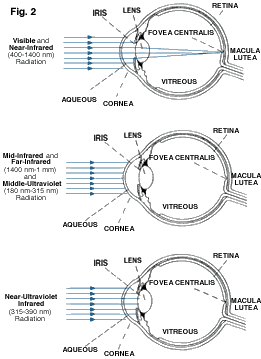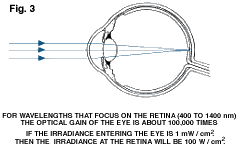Laser Safety Information
Useful Resources
What is a laser
LASER is an acronym which stands for Light Amplification by Stimulated Emission of Radiation. The energy generated by the laser is in or near the optical portion of the electromagnetic spectrum (see Figure 1). Energy is amplified to extremely high intensity by an atomic process called stimulated emission. The term "radiation" is often misinterpreted because the term is also used to describe radioactive materials or ionizing radiation. The use of the word in this context, however, refers to an energy transfer. Energy moves from one location to another by conduction, convection, and radiation. The color of laser light is normally expressed in terms of the laser's wavelength. The most common unit used in expressing a laser's wavelength is a nanometer (nm). There are one billion nanometers in one meter.

Laser Hazards & Beam Hazards
The laser produces an intense, highly directional beam of light. If directed, reflected, or focused upon an object, laser light will be partially absorbed, raising the temperature of the surface and/or the interior of the object, potentially causing an alteration or deformation of the material. These properties which have been applied to laser surgery and materials processing can also cause tissue damage. In addition to these obvious thermal effects upon tissue, there can also be photochemical effects when the wavelength of the laser radiation is sufficiently short, i.e., in the ultraviolet or blue region of the spectrum. Today, most high-power lasers are designed to minimize access to laser radiation during normal operation. Lower-power lasers may emit levels of laser light that are not a hazard.
The human body is vulnerable to the output of certain lasers, and under certain circumstances, exposure can result in damage to the eye and skin. Research relating to injury thresholds of the eye and skin has been carried out in order to understand the biological hazards of laser radiation. It is now widely accepted that the human eye is almost always more vulnerable to injury than human skin. The cornea (the clear, outer front surface of the eye's optics), unlike the skin, does not have an external layer of dead cells to protect it from the environment. In the far-ultraviolet and far-infrared regions of the optical spectrum, the cornea absorbs the laser energy and may be damaged. Figure 2 illustrates the absorption characteristics of the eye for different laser wavelength regions. At certain wavelengths in the near-ultraviolet region and in the near-infrared region, the lens of the eye may be vulnerable to injury. Of greatest concern, however, is laser exposure in the retinal hazard region of the optical spectrum, approximately 400 nm (violet light) to 1400 nm (near-infrared) and including the entire visible portion of the optical spectrum. Within this spectral region collimated laser rays are brought to focus on a very tiny spot on the retina. This is illustrated in Figure 3.


In order for the worst case exposure to occur, an individual's eye must be focussed at a distance and a direct beam or specular (mirror-like) reflection must enter the eye. The light entering the eye from a collimated beam in the retinal hazard region is concentrated by a factor of 100,000 times when it strikes the retina. Therefore, a visible, 10 milliwatt/cm2 laser beam would result in a 1000 watt/cm2 exposure to the retina, which is more than enough power density (irradiance) to cause damage. If the eye is not focussed at a distance or if the beam is reflected from a diffuse surface (not mirror-like), much higher levels of laser radiation would be necessary to cause injury. Likewise, since this ocular focussing effect does not apply to the skin, the skin is far less vulnerable to injury from these wavelengths.
If the eye is not focussed at a distance or if the beam is reflected from a diffuse surface (not mirror-like), much higher levels of laser radiation would be necessary to cause injury. Likewise, since this ocular focussing effect does not apply to the skin, the skin is far less vulnerable to injury from these wavelengths.
Non-Beam Hazards
In addition to the direct hazards to the eye and skin from the laser beam itself, it is also important to address other hazards associated with the use of lasers. These non-beam hazards, in some cases, can be life threatening, e.g. electrocution, fire, and asphyxiation. Table 1 indicates some of the potential non-beam hazards associated with laser usage. Because of the diversity of these hazards, the employment of safety and/or industrial hygiene personnel to effect the hazard evaluations may be necessary.
